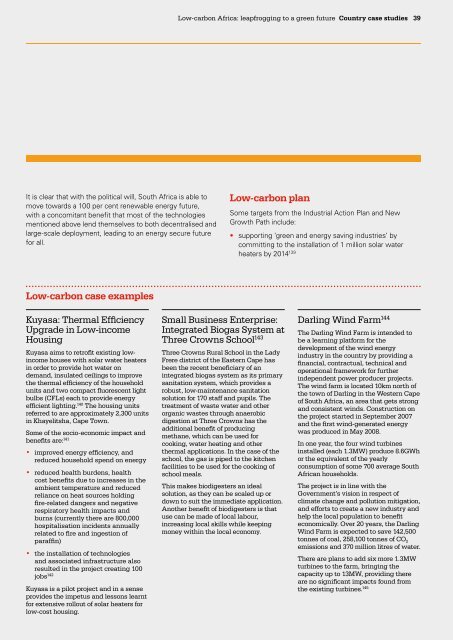Ju8uG
Ju8uG
Ju8uG
Create successful ePaper yourself
Turn your PDF publications into a flip-book with our unique Google optimized e-Paper software.
Low-carbon Africa: leapfrogging to a green future Country case studies<br />
39<br />
It is clear that with the political will, South Africa is able to<br />
move towards a 100 per cent renewable energy future,<br />
with a concomitant benefit that most of the technologies<br />
mentioned above lend themselves to both decentralised and<br />
large-scale deployment, leading to an energy secure future<br />
for all.<br />
Low-carbon plan<br />
Some targets from the Industrial Action Plan and New<br />
Growth Path include:<br />
• supporting ‘green and energy saving industries’ by<br />
committing to the installation of 1 million solar water<br />
heaters by 2014 139<br />
Low-carbon case examples<br />
Kuyasa: Thermal Efficiency<br />
Upgrade in Low-income<br />
Housing<br />
Kuyasa aims to retrofit existing lowincome<br />
houses with solar water heaters<br />
in order to provide hot water on<br />
demand, insulated ceilings to improve<br />
the thermal efficiency of the household<br />
units and two compact fluorescent light<br />
bulbs (CFLs) each to provide energy<br />
efficient lighting. 140 The housing units<br />
referred to are approximately 2,300 units<br />
in Khayelitsha, Cape Town.<br />
Some of the socio-economic impact and<br />
benefits are: 141<br />
• improved energy efficiency, and<br />
reduced household spend on energy<br />
• reduced health burdens, health<br />
cost benefits due to increases in the<br />
ambient temperature and reduced<br />
reliance on heat sources holding<br />
fire-related dangers and negative<br />
respiratory health impacts and<br />
burns (currently there are 800,000<br />
hospitalisation incidents annually<br />
related to fire and ingestion of<br />
paraffin)<br />
• the installation of technologies<br />
and associated infrastructure also<br />
resulted in the project creating 100<br />
jobs 142<br />
Kuyasa is a pilot project and in a sense<br />
provides the impetus and lessons learnt<br />
for extensive rollout of solar heaters for<br />
low-cost housing.<br />
Small Business Enterprise:<br />
Integrated Biogas System at<br />
Three Crowns School 143<br />
Three Crowns Rural School in the Lady<br />
Frere district of the Eastern Cape has<br />
been the recent beneficiary of an<br />
integrated biogas system as its primary<br />
sanitation system, which provides a<br />
robust, low-maintenance sanitation<br />
solution for 170 staff and pupils. The<br />
treatment of waste water and other<br />
organic wastes through anaerobic<br />
digestion at Three Crowns has the<br />
additional benefit of producing<br />
methane, which can be used for<br />
cooking, water heating and other<br />
thermal applications. In the case of the<br />
school, the gas is piped to the kitchen<br />
facilities to be used for the cooking of<br />
school meals.<br />
This makes biodigesters an ideal<br />
solution, as they can be scaled up or<br />
down to suit the immediate application.<br />
Another benefit of biodigesters is that<br />
use can be made of local labour,<br />
increasing local skills while keeping<br />
money within the local economy.<br />
Darling Wind Farm 144<br />
The Darling Wind Farm is intended to<br />
be a learning platform for the<br />
development of the wind energy<br />
industry in the country by providing a<br />
financial, contractual, technical and<br />
operational framework for further<br />
independent power producer projects.<br />
The wind farm is located 10km north of<br />
the town of Darling in the Western Cape<br />
of South Africa, an area that gets strong<br />
and consistent winds. Construction on<br />
the project started in September 2007<br />
and the first wind-generated energy<br />
was produced in May 2008.<br />
In one year, the four wind turbines<br />
installed (each 1.3MW) produce 8.6GWh<br />
or the equivalent of the yearly<br />
consumption of some 700 average South<br />
African households.<br />
The project is in line with the<br />
Government’s vision in respect of<br />
climate change and pollution mitigation,<br />
and efforts to create a new industry and<br />
help the local population to benefit<br />
economically. Over 20 years, the Darling<br />
Wind Farm is expected to save 142,500<br />
tonnes of coal, 258,100 tonnes of CO 2<br />
emissions and 370 million litres of water.<br />
There are plans to add six more 1.3MW<br />
turbines to the farm, bringing the<br />
capacity up to 13MW, providing there<br />
are no significant impacts found from<br />
the existing turbines. 145


